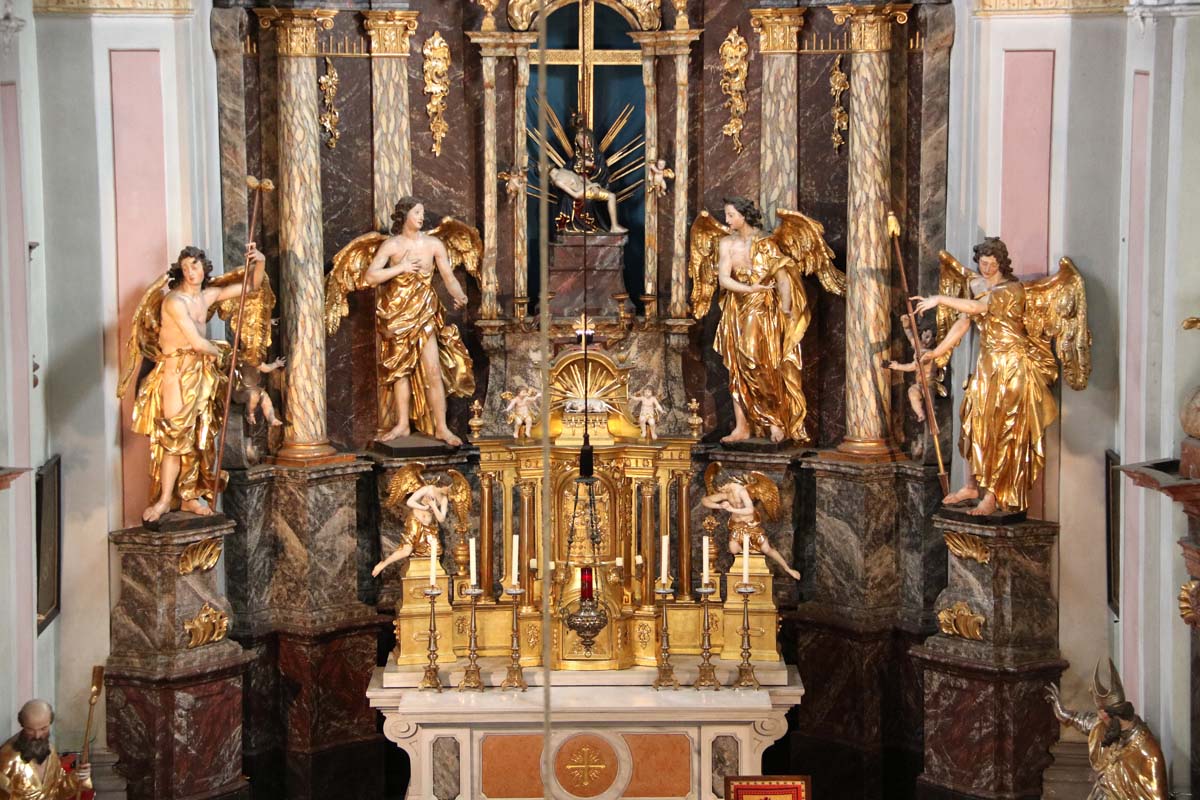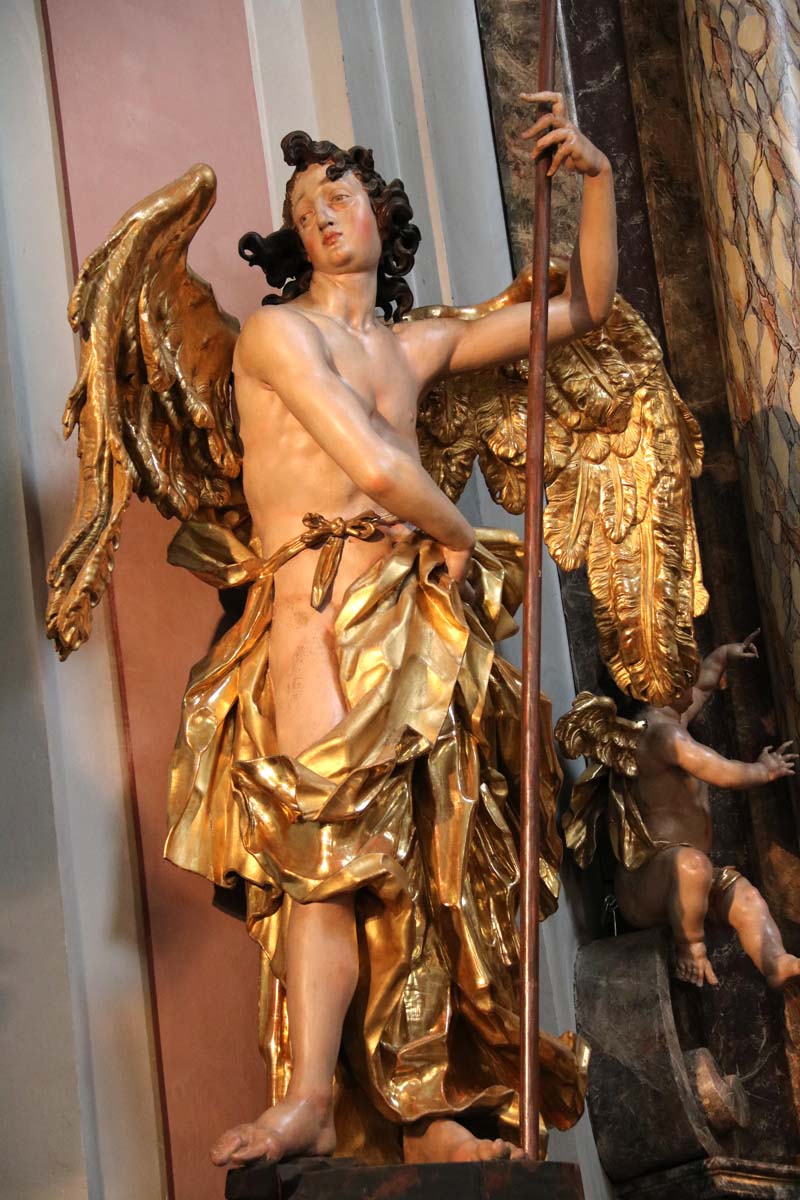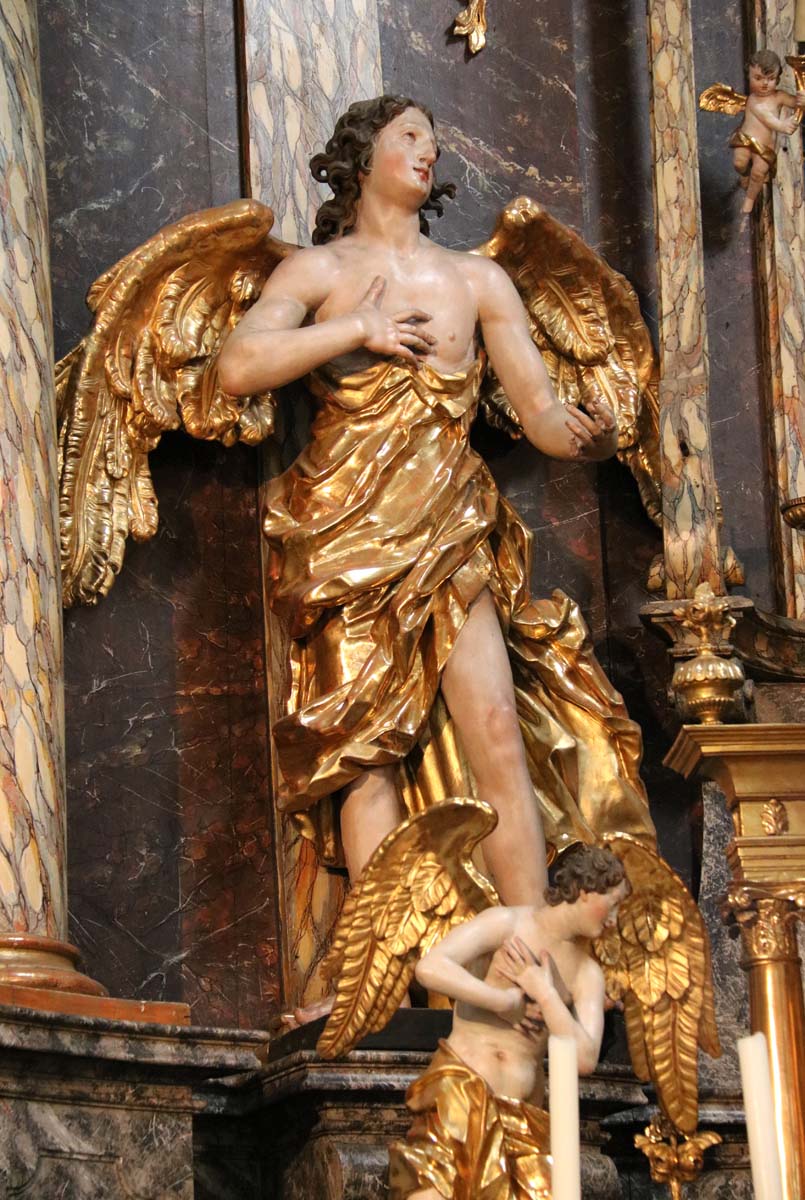Location
Austria, Styria, Ehrenhausen
Parish and Pilgrimage Church Our Lady of Sorrows ((Pfarr- und Wallfahrtskirche Schmerzhafte Mutter Maria))
Ehrenhausen
Artwork
The high altar of the Parish Church Our Lady of Sorrows in Ehrenhausen
Type
High altar
Dimensions
Height: 1100 cm, width: 665 cm, depth: 270 cm
Inscriptions
- "1863" (on the globe in the attic)
Critical History
The ground stone of the new parish church of Ehrenhausen was layed in April 1751 under the patronage of the noble family Eggenberg-Leslie and in 1753 the building must have been finished for the greater part.1 The payments in 1752 and 1753 well documented in the parish archives comfirm this state of the construction progress.2 So far, no evidence has been found in the archives to identify the architect. Numerous attributions based on stylistic similarities were suggested by different researchers, for example Joseph Hueber, Johann Georg Stengg, both from Graz, or Johann Fuchs and Josef Hoffer from Maribor.3 The consecration of the parish and pilgrimage church Our Lady of Sorrows was held on July 5, 1754, a date also confirmed by the chronogramme on the pedestal of the Pietà on the façade above the main entrance.4 The high altar, the pulpit and two side altars were attributed to Philipp Jakob Straub due to stilistic reasons by Andorfer in 1938; Schweigert attributes the side altars and the tabernacle with angels of the high altar to Veit Königer, but agrees with the assumed authorship of Philipp Jakob Straub regarding the style of the monumental figures on the high altar, the pulpit and the decoration of the church façade; he dates the high altar between 1752/53 and around 1755.5 New research in the parish archives, now in the archive of the diocese Graz-Seckau, could not confirm any payment to the sculptor, only to his younger brother Joseph Straub from Maribor, probably for the decoration of the façade.6
Construction / Execution
In the central niche of the wooden altar architecture consisting of high columns and pilasters, a small gothic Pietà is situated on a pedestal surrounded by four monumental angels of approximately 210 cm height. The two angels with arma Christi (the stick with the sponge of vinegar and the lance) on the far left and far right side are each placed on independent pedestals. The rest of the construction is fixed on the rear wall of the presbytery. Godfather and the Holy Spirit in the attic are flanked by two kneeling angels.
Components
- Carpentry
- Completed: ca. 1753 – ca. 1754
- Technique(s): sawing
- Material(s): wood
- Sculpture
- Author: Philipp Jakob Straub (Wiesensteig 1706 – Graz 1774)
- Completed: ca. 1753 – ca. 1754
- Patron(s): Maria Charlotte of Eggenberg , noble; Maria Theresia Josepha of Eggenberg, noble; Cajetan Count Leslie , noble
- Technique(s): wood carving
- Material(s): limewood
- Sculpture
- Pietà
- Completed: ca. 1420
- Technique(s): casting
- Material(s): stone
- Polychromy
- Author: Franz Rahmer
- Completed: ca. 1766 – ca. 1770
- Polychromy
- First Repolychromy
- Author: Bauer
- Completed: 1863 – 1864
- Patron(s): multiple, parishioners
Comment
Long after the consecration of the church, in 1766, parish priest Franz Xaver Herrender (Hörrender) noted that the five altars were still lacking polychromy and gilding.7 Several payments to gilders are documented for 1770.8 A second gilding by a gilder named Bauer (1512 fl.) was undertaken in 1863 under parish priest Franz Kleinoschegg (compare ins. I.). A donation of 2100 fl. by Maria Hammer, a farmer's wife, made the restauration works possible.9
Images
- Ehrenhausen, Our Lady of Sorrows, high altar, ca. 1753-1754 (photo by Julia Strobl, 2018)
- Ehrenhausen, high altar, figures by Philipp Jakob Straub, ca. 1753-1754 (photo by Julia Strobl, 2018)
- Ehrenhausen, high altar, left angel with the sponge of vinegar (photo by Julia Strobl, 2018)
- Ehrenhausen, high altar, left angel in devotion (photo by Julia Strobl, 2018)
- Ehrenhausen, high altar, right angel in devotion (photo by Julia Strobl, 2018)
- Ehrenhausen, high altar, right angel with the lance (photo by Julia Strobl, 2018)
Catalogue entry prepared by Julia Strobl
Recommended citation: Julia Strobl, The high altar of the Parish Church Our Lady of Sorrows in Ehrenhausen, in: TrArS – Tracing the Art of the Straub Family, 2018, (accessed 14/11/2025) URL






